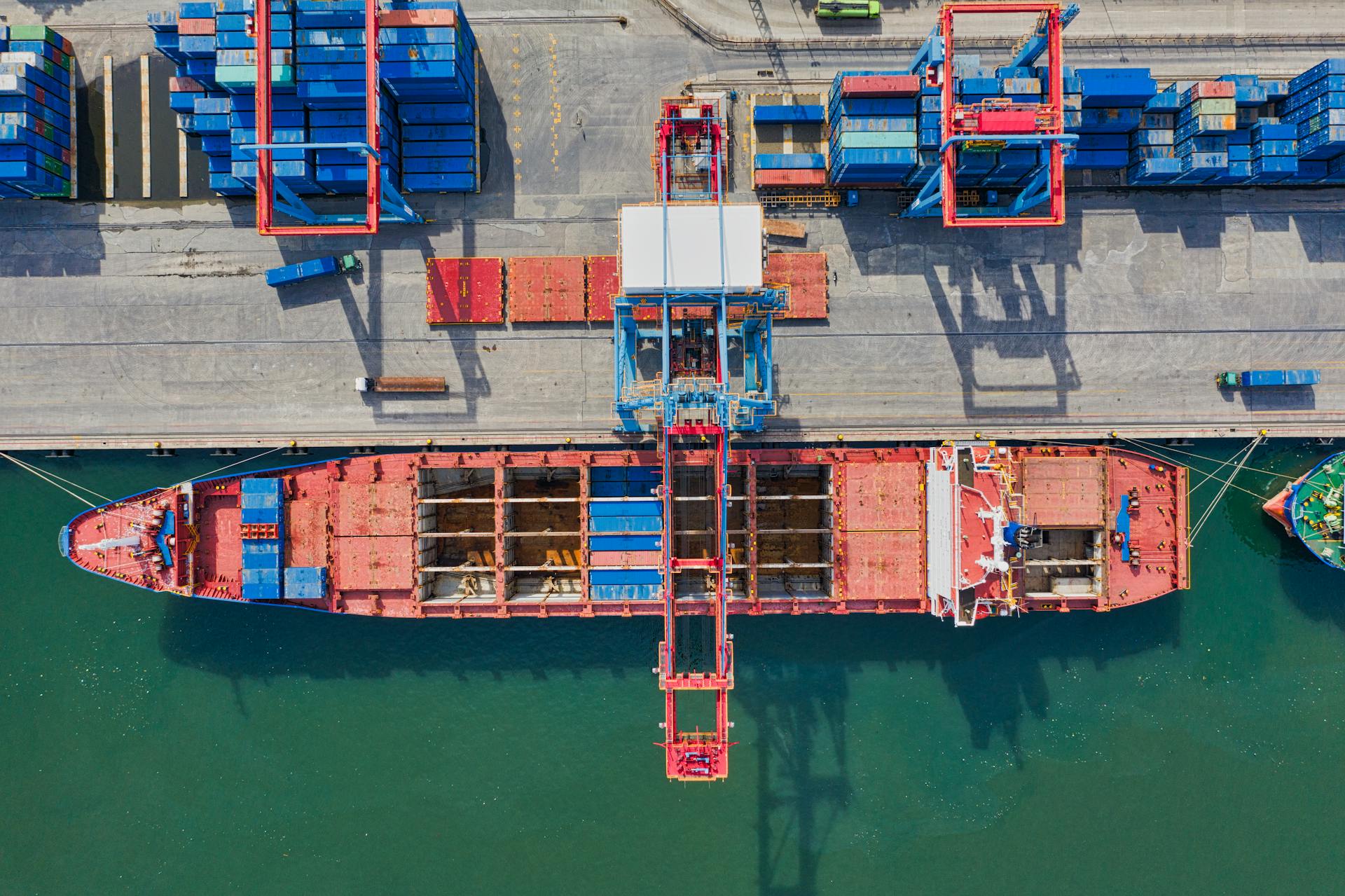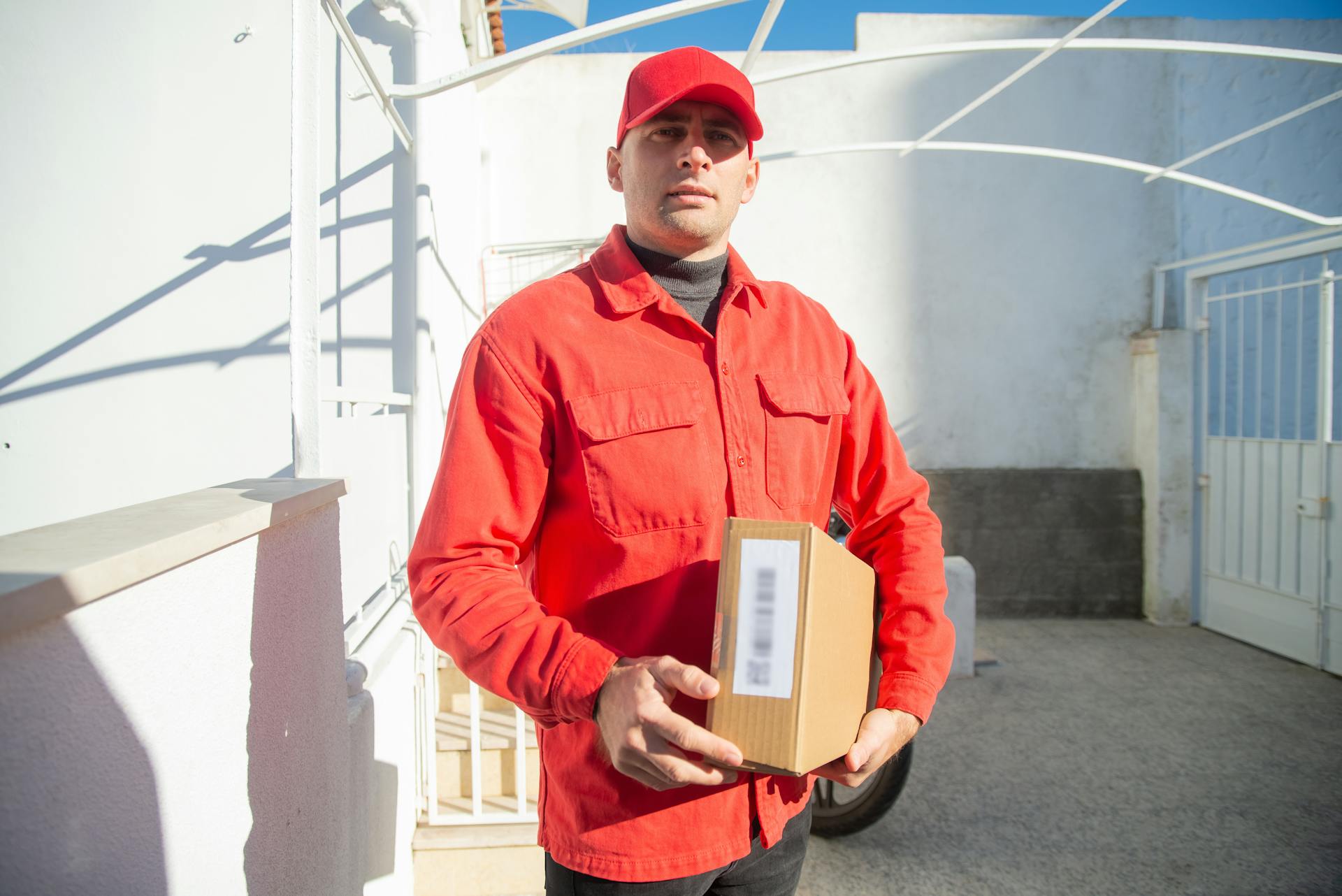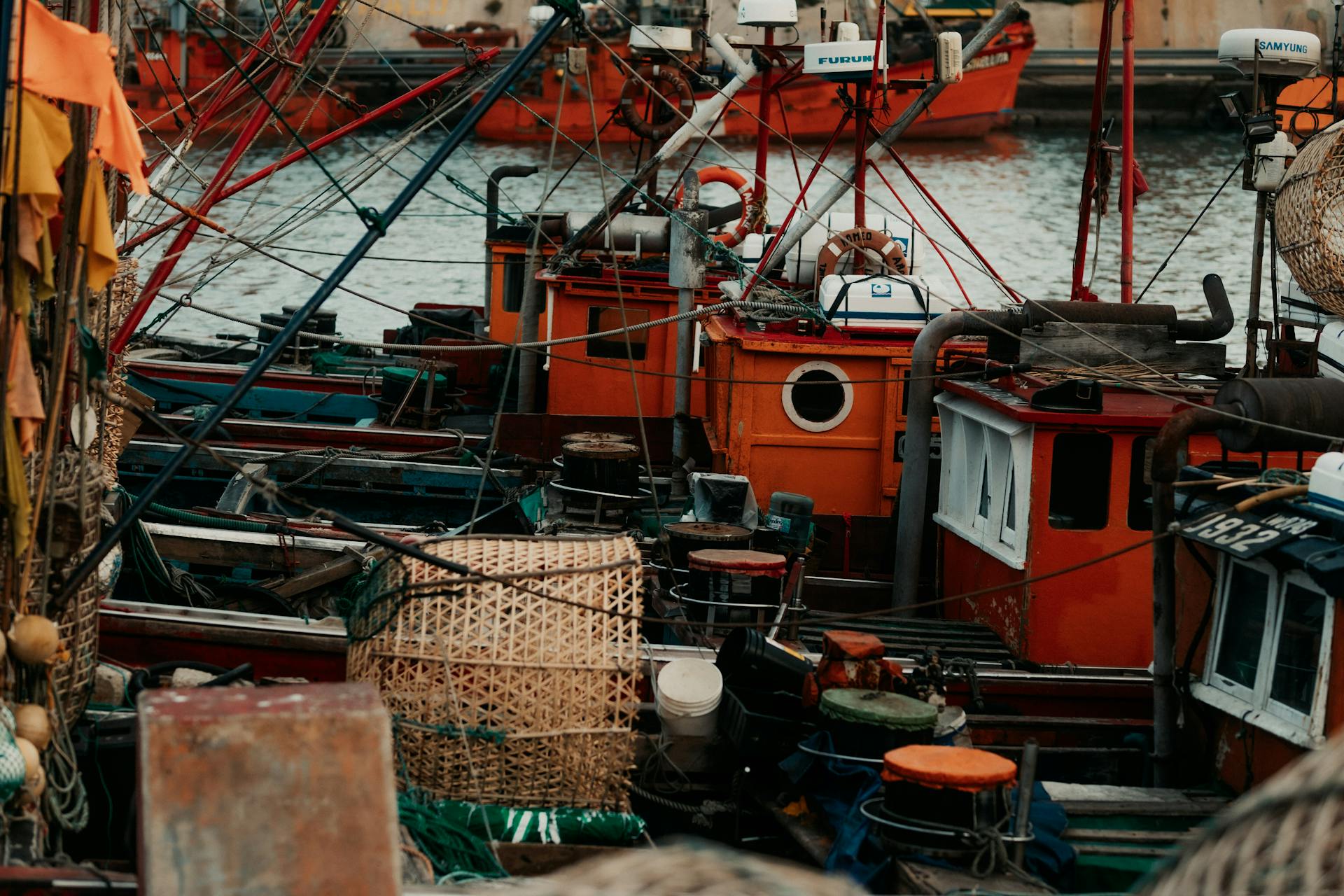
Pakistan has a long coastline along the Arabian Sea and the Gulf of Oman, which makes it a significant player in the global maritime trade. The country has a total of 9 major ports, including the Port of Karachi, which is the largest and busiest port in the country.
The Port of Karachi is strategically located near the center of the country, making it a crucial hub for trade and commerce. It handles a significant portion of Pakistan's international trade, including the import and export of goods such as textiles, machinery, and petroleum products.
Pakistan's ports are an essential part of the country's economy, providing a vital link between the country and the rest of the world. The ports also play a significant role in the country's industrial development, particularly in the manufacturing and processing of goods.
Readers also liked: Karachi Dock Labour Board
Major Karachi Harbor
The Karachi Harbor is a vital part of Pakistan's economy, handling nearly 60% of national shipments. It's a large deep-sea port operated along the Arabian Sea coast of Pakistan, owned by the Ministry of Maritime Affairs and managed by the Karachi Port Trust (KPT).
For another approach, see: Sea Ports in Japan
Karachi Port has been operational since the early 18th century, but it wasn't until the British rule that it became an important port. The modern harbor was opened in 1854 off the Pakistan coast and has since been integrated into the mainland by way of causeways and bridges.
The port boasts an impressive annual cargo of 65.25 million tons and 1.56 million TEUs. It has a maximum capacity of 75,000 DWT for docking vessels and features 3 liquid cargo berths, shipyards and repair sites, 2 dry docks, and 3 container terminals.
The Karachi International Container Terminal (KICT) on the West wharf can handle Panamax and Post-Panamax vessels along 600 meters of berthing space. The Pakistan International Bult Terminal (PIBT) on the East wharf can process Panamax vessels with an annual capacity of 350,000 TEUs.
Here are some key statistics about the Karachi Harbor:
The Karachi Harbor is a vital part of Pakistan's economy, and its importance is expected to continue with expansionary projects to improve the port's facilities.
Gwadar and Other Ports
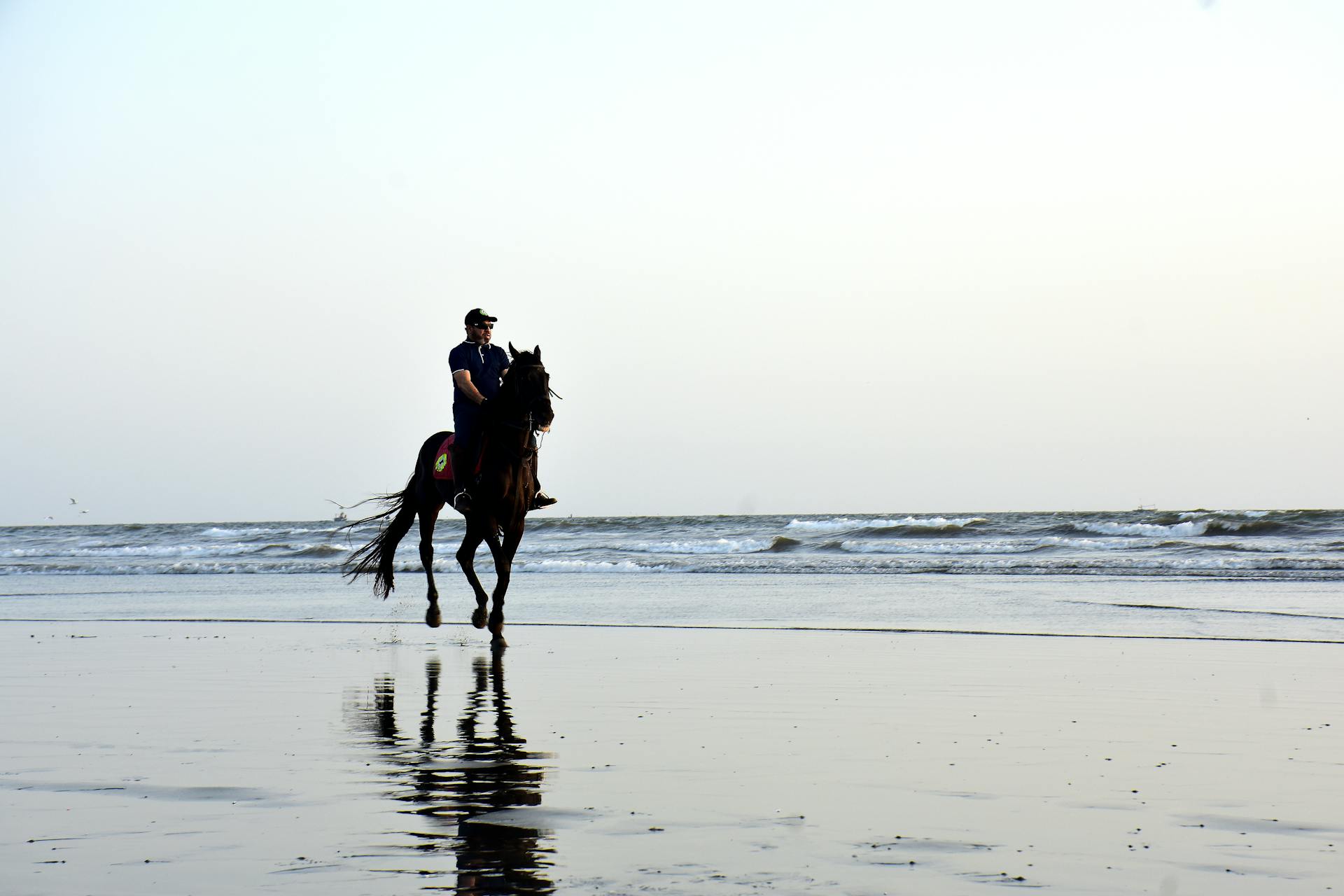
Gwadar Port is a major player in Pakistan-Afghanistan trade transit and is a hub of the proposed China-Pakistan Economic Corridor (CPEC). The port is located near Chabahar Port in Iran and close to the Gulf of Oman and Straits of Hormuz.
The port has a current annual container capacity of 30 million TEUs as of 2018 and a proposed cargo capacity of 400 million tons by 2045. It features a floating liquefied natural gas facility, the Gwadar Special Economic Zone, and a dedicated facility to promote CPEC interests.
Gwadar Port is officially leased to China until 2059 and houses an oil recovery system. It is closely connected to National Highway (N-10) and is an important part of the CPEC plan.
The port is a deep-sea port and has been operational since 2016. It is still under expansionary activities planned in 3 subsequent phases, with delivery in 2029 and 2045 for the pending 2 stages. The proposed ship classes to be supported are: Bulk carriers – 30,000 DWT, Panamax – 52,000 DWT, Neo Panamax – 200,000 DWT, Chinamax – 400,000 DWT, Valemax – 400,000 DWT, and TI-Class Supertankers – 440,000 DWT.
Suggestion: China Sea Ports
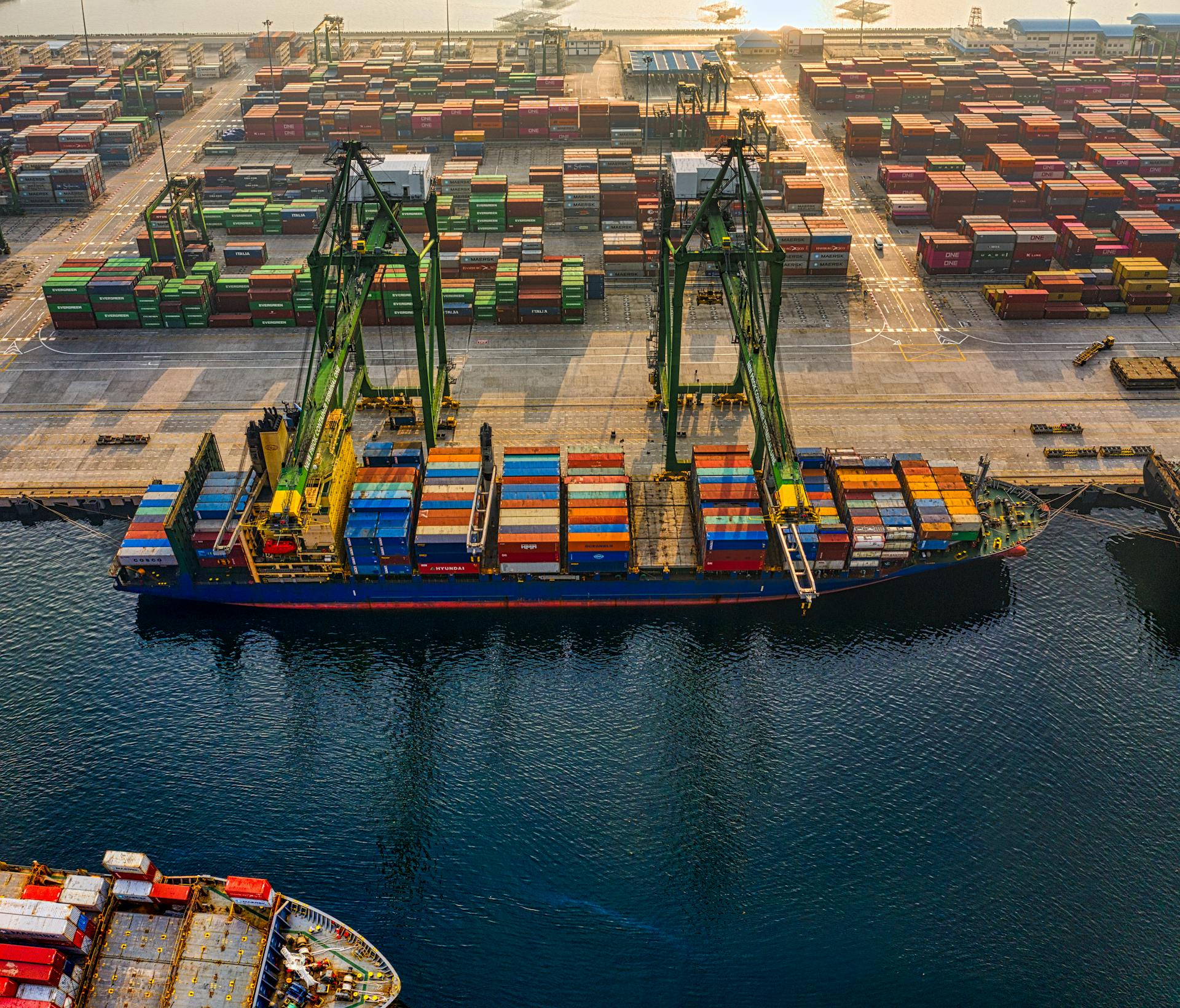
Other notable ports in Pakistan include Port of Jiwani, located on the Western extent of Pakistan and situated on the Gulf of Oman. Pasni Port, a medium seaport, fishing harbour, and naval base on the Makran Coast, handles shipments from other Pakistani Ports to supplement food and other products for the locals.
Here's a list of some of the key ports in Pakistan:
- Gwadar Port: a major port on the Arabian Sea under the administration of the Gwadar Port Authority.
- Port of Jiwani: a defense and commercial harbor situated on the Gulf of Oman.
- Pasni Port: a medium seaport, fishing harbour, and naval base on the Makran Coast.
Gwadar
Gwadar is a major port in Pakistan located on the Arabian Sea in the Balochistan Province. It's a significant player in Pakistan-Afghanistan trade transit and a hub for the China-Pakistan Economic Corridor (CPEC).
Gwadar is a deep-sea port that has been operational since 2016 and is currently undergoing expansionary activities. The harbour is linked to the Maritime Silk Road and Belt & Road Projects, making it a crucial part of the global trade network.
The port is operated and managed by the Gwadar Port Authority and the China Overseas Port Holding Company. It features a floating liquefied natural gas facility, the Gwadar Special Economic Zone, and a dedicated facility to promote CPEC interests.
You might like: Gwadar Airport Pakistan
As of 2018, the current annual container capacity of Gwadar Port is 30 million TEUs. The proposed cargo capacity is 400 million tons by 2045, which is a significant increase from the current capacity of 11 million tons.
The port is designed to support various ship classes, including bulk carriers, Panamax, Neo Panamax, Chinamax, Valemax, and TI-Class Supertankers. This will enable Gwadar to handle a wide range of cargo and become a major hub for international trade.
Here's a breakdown of the proposed ship classes to be supported at Gwadar Port:
The expansion of Gwadar Port is planned to take place in three stages, with the second and third stages expected to be completed in 2029 and 2045, respectively. This will enable the port to handle even larger cargo vessels and become a major player in the global trade market.
Gadani Harbour
Gadani Harbour is an important global hub for ship breaking and scraping, located on the Arabian Sea and close to Karachi Port.
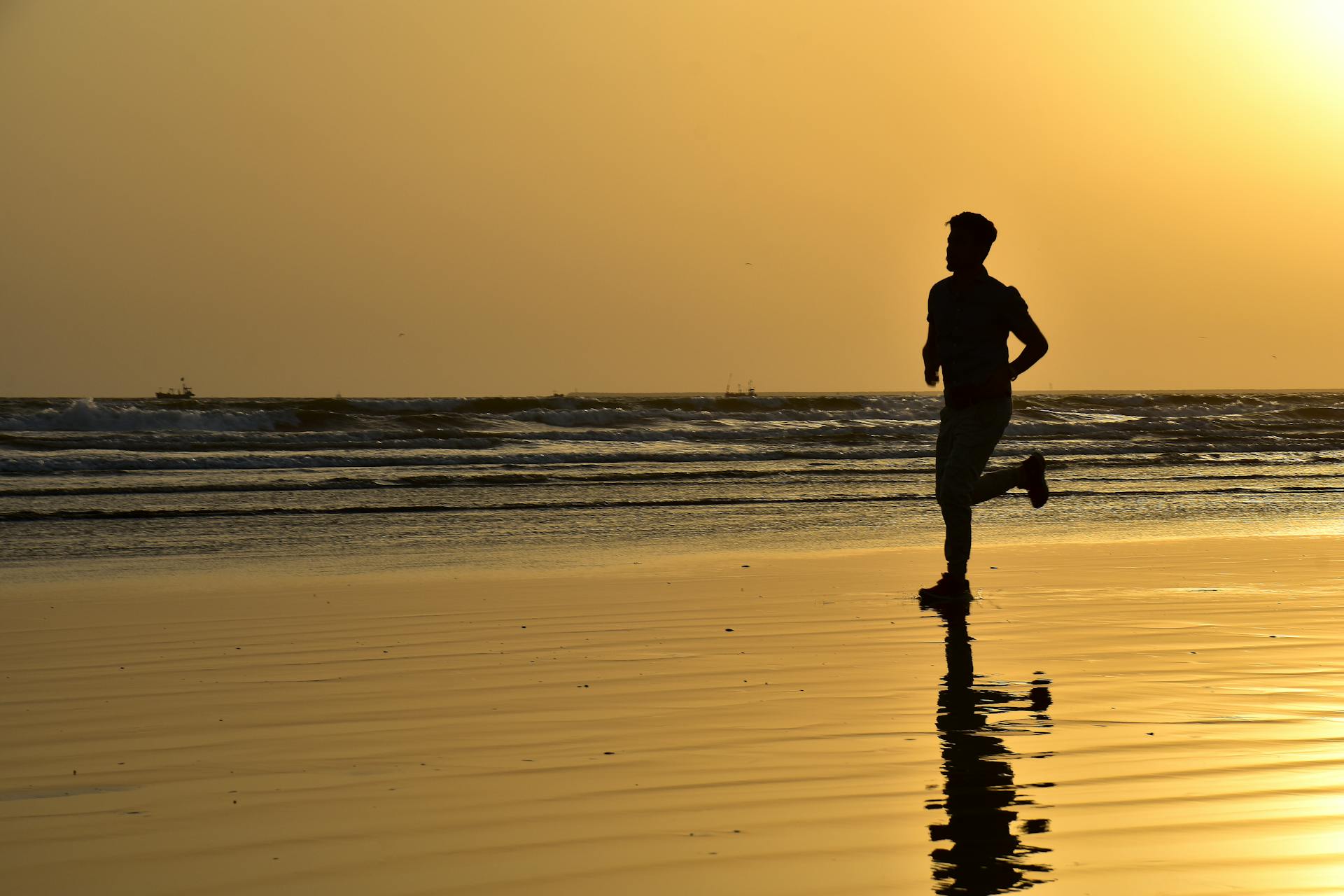
It's the third-largest ship-breaking yard in the world, directly competing with yards in Alang (India), Chittagong (Bangladesh), and Aliağa (Turkey).
Gadani currently employs around 6,000 workers and staff to scrap an annual tonnage of nearly 1 billion tons.
In 2009-10, a record 107 ships were broken, with a combined Light Displacement (LDT) of over 850,000 tons scrapped, an improvement of 7% over the preceding year.
The harbour's current capacity is breaking 125 ships annually with DWT up to 1,000,000 DWT (supertankers).
Gadani is the most efficient ship-breaking yard, with a capacity of breaking vessels at over 3 times the speed of Alang and Chittagong.
The Government of Pakistan revitalized the harbour by reducing taxes and duties by 5% to incentivize workers and ship owners to prefer Gadani over competing facilities.
Discover more: East India Trading Company Ship
Pasni
Pasni is a medium-sized sea port on the Makran Coast in Balochistan, with a fishing harbour and naval facility.
Fishing is the principal source of income in the adjacent hinterlands, and the port also receives shipments from other Pakistani ports to replenish food and other products for the locals.
The port has modern facilities to process and package produce for export, and a significant portion of the export shipments from Pasni is destined for Turbat and Karachi.
The Pasni Port is well connected by road and air to the major cities of Pakistan, and the Naval Base in Pasni is a hub of activity that has resulted in the development of the nearby Pasni Airport and the National Highways.
The port is operated by the Government of Balochistan Port Authority (BPA), and the harbour is owned by the Maritime Affairs Secretary of Pakistan.
The catch is usually processed in the port premises, packaged for export, and sent to the numerous fishing harbours at Karachi Port, where it meets requirements for export to EU countries.
The port has the latest goods processing and packaging equipment, which meets the EU export criteria.
The Pasni Naval Base is a hub of activity that has resulted in the construction of the surrounding Pasni Airport and national highways, connecting the port to major cities of the country.
For your interest: Alaska Port Cities
Jiwani
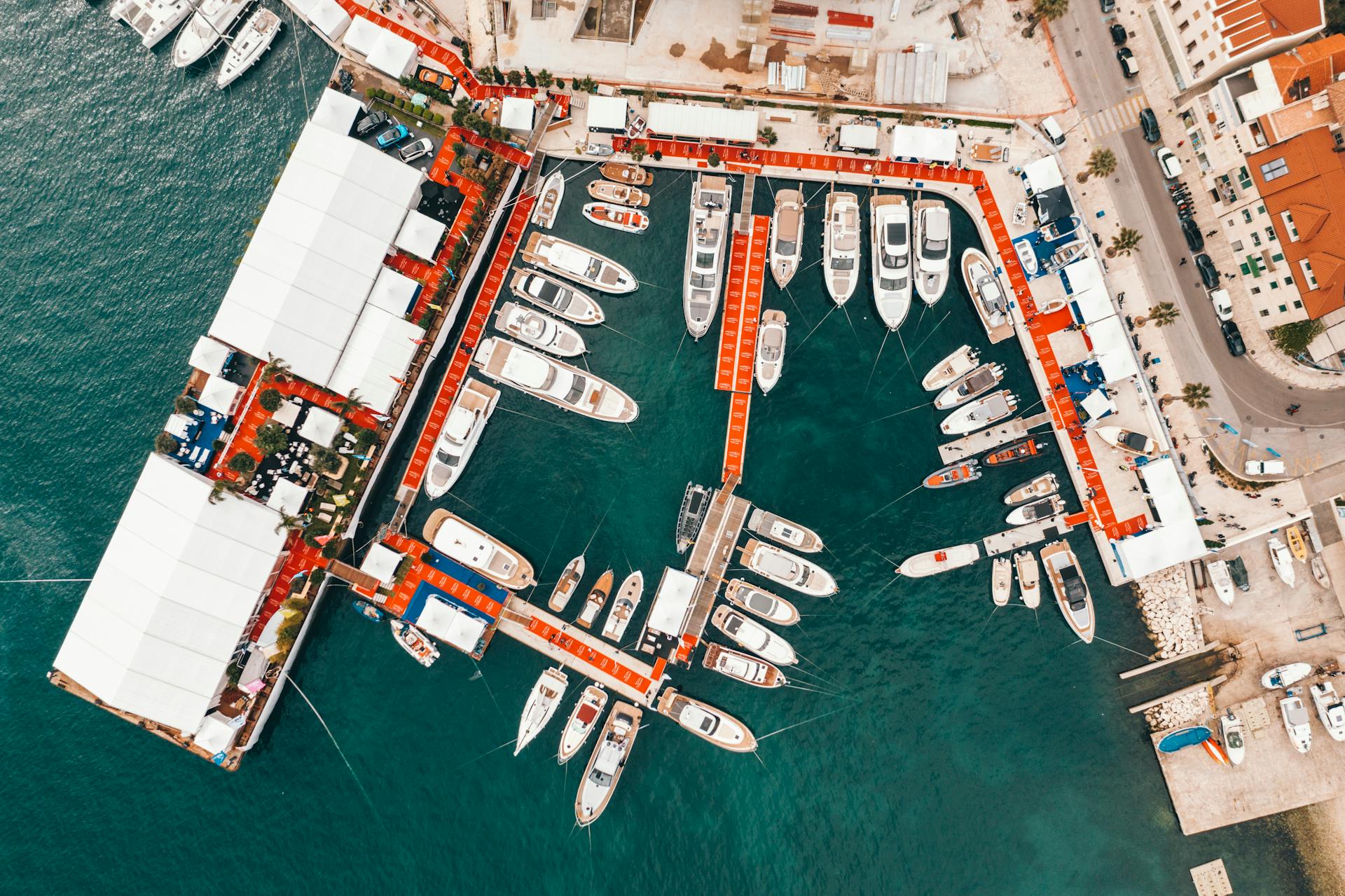
Jiwani is a port located on Pakistan's western border, situated on the Gulf of Oman. It's a naval and commercial harbor, close to the ports of Gwadar, Pakistan, and Chabahar, Iran.
The port's proximity to these shipping hubs has led to the development of Jiwani and its surrounding areas. This has resulted in a growth in the local economy.
Located in Gwadar Bay, Port Jiwani holds immense importance from a naval point of view. It's close to the Straits of Hormuz, the Persian Gulf, and the Gulf of Oman, all of which are prominent shipping routes.
During World War II, Jiwani was a major Allied base for both the Navy and Air Force. This strategic location has made it an attractive spot for military bases in the present day.
China is in talks to set up a base at Jiwani, which would be the second Chinese Naval Base in Pakistan, after Gwadar. This move is expected to supplement their maritime presence.
The port is well-connected to major cities via the Makran Highway and the Jiwani Military Airport, which transports fresh goods.
Readers also liked: Yemen Gulf of Aden Ports Corporation
Military and Shipyards

Pakistan has a significant naval presence, with several military ports and bases along its coast. Karachi Naval Dockyard is located in Keamari District, while Jinnah Naval Base is situated in Ormara, Gwadar District.
The country also has several naval ships, including PNS Akram in Gwadar District, PNS Himalaya in Manora Cantonment, and PNS Qasim in Manora Cantonment.
In addition to these military facilities, Pakistan has a number of shipyards, including Gadani Ship Breaking Yard in Hub District, which is one of the largest in the country.
Recommended read: EXIM Bank of Pakistan
Jinnah Naval Base
The Jinnah Naval Base is Pakistan's premier Naval Base and the second largest in the country. It's located on the Makran Coastal Highway in the Balochistan Province.
The base is situated 240 kms to the West of Karachi Port Harbour and Gwadar Port. It's exclusively owned and operated by the Pakistan Navy.
The construction of the base was undertaken by several organizations based out of Pakistan, Belgium, and Turkey. The final contract was executed by STFA and STM (Turkey), Jan De Nul (Belgium), and FWO and MES (Pakistan).
For more insights, see: Customs Clearance Turkey

The base was commissioned in 2000, following 6 years of construction and outfitting. It's staffed by the Ministry of Defence.
The Port boasts world-class facilities to berth and service naval vessels. With berths for warships, submarines, and other naval assets, the port is a major hub for shipbuilding and maintenance activities.
At present, the port is capable of servicing up to 8 warships and 4 submarines simultaneously.
Military
In Pakistan, there are several key military ports and bases that play a crucial role in the country's defense.
The Karachi Naval Dockyard, located in Keamari District, is one of these important military ports.
The Jinnah Naval Base in Ormara, Gwadar District, is another significant military port.
Here are some notable military ships based in Pakistan:
- PNS Akram, located in Gwadar District
- PNS Himalaya, based in Manora Cantonment
- PNS Qasim, also based in Manora Cantonment
Shipyards
Pakistan has a number of shipyards that play a crucial role in the country's maritime industry.
The Gadani Ship Breaking Yard in the Hub District is a major player in this sector. It's a significant facility that contributes to the country's economy.
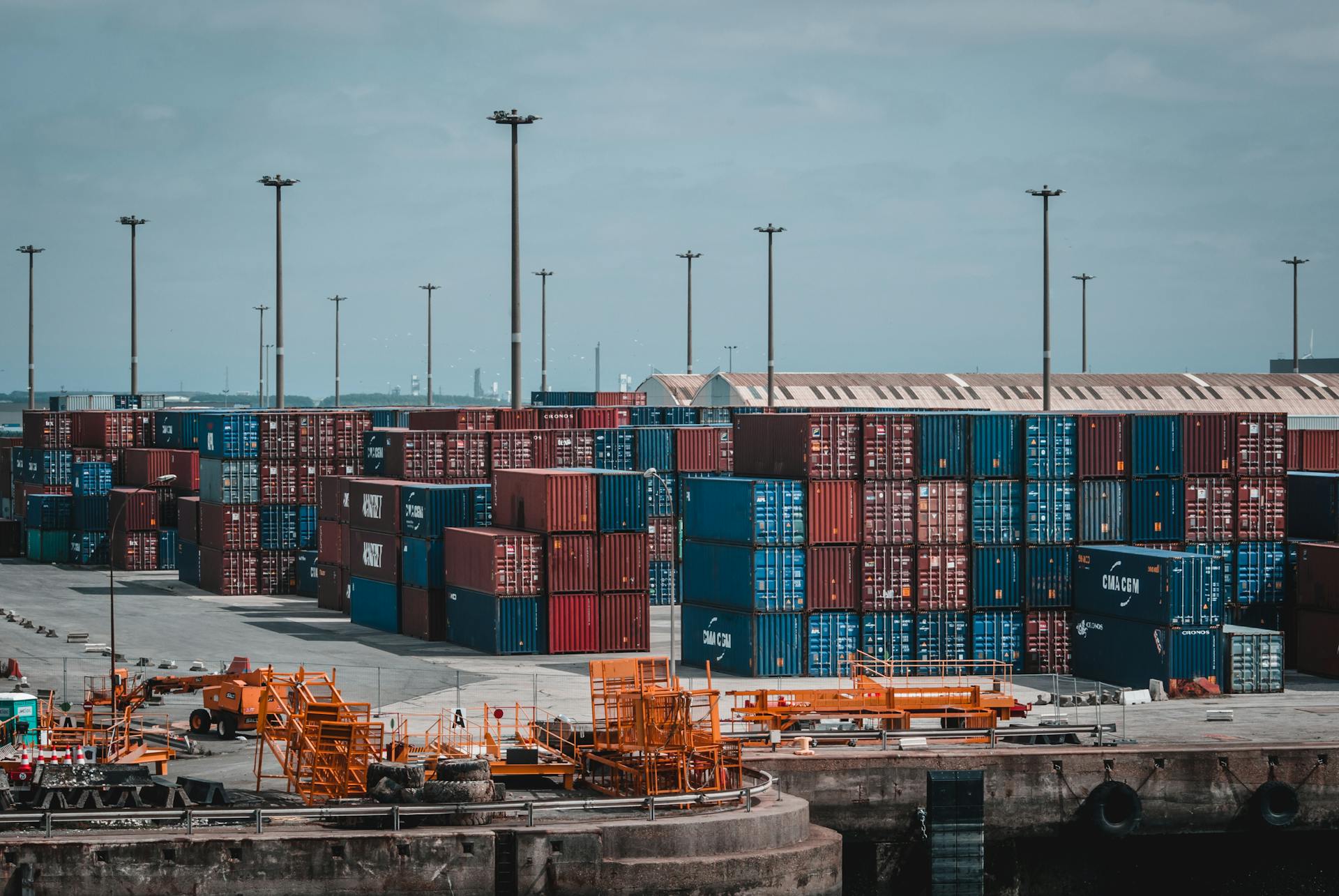
Gwadar Shipyard, proposed for the Gwadar District, aims to further boost Pakistan's shipbuilding capabilities.
Karachi Shipyard & Engineering Works, located in the Keamari District, is another key shipyard in the country.
Here are some of the notable shipyards in Pakistan:
- Gadani Ship Breaking Yard, Hub District
- Gwadar Shipyard, Gwadar District (proposed)
- Karachi Shipyard & Engineering Works, Keamari District
Dry Ports
Dry ports are an essential part of Pakistan's logistics and trade infrastructure. They allow goods to undergo customs checks away from the dock side, making the process more efficient.
Pakistan Railways runs six major dry ports, which were opened between 1973 and 1990. These include Lahore Dry Port, Karachi Dry Port, Quetta Dry Port, Peshawar Dry Port, Multan Dry Port, and Rawalpindi Dry Port.
Private companies also operate dry ports in the country. Some of these include Sialkot Dry Port, Faisalabad Dry Port, and Pak-China Sust Dry Port.
Here's a list of some of the dry ports in Pakistan, including their locations and opening years:
- Lahore Dry Port (1973)
- Karachi Dry Port (1974)
- Sialkot Dry Port (1986)
- Faisalabad Dry Port (1994)
- Pak-China Sust Dry Port (1986)
- NLC Dry Port at Thokar Niaz Beg (no opening year mentioned)
- NLC Dry Port at Quetta (no opening year mentioned)
- QICT Dry port at Prem Nagar railway station (2010)
- Sialkot International Container Terminal (no opening year mentioned)
Commercial and Proposed Ports
Pakistan has a total of 7 commercial seaports, with Karachi Port being the busiest, handling 60% of national shipments.
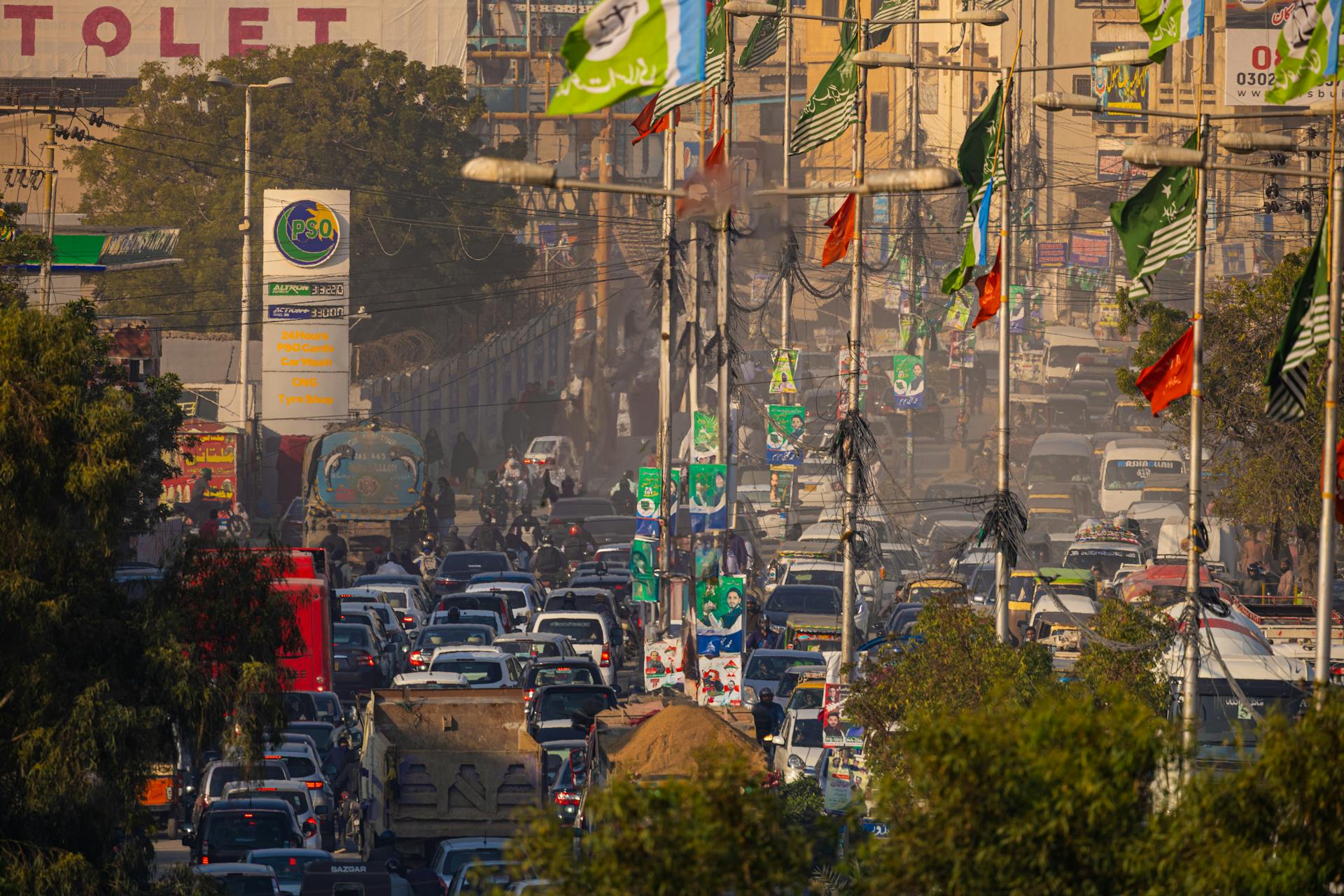
Karachi Port is a natural harbour owned by the Ministry of Maritime Affairs and operated by the Karachi Port Trust (KPT).
Gwadar Port is another significant seaport, operated and managed by the Gwadar Port Authority and the China Overseas Port Holding Company.
The Port of Jiwani, located on Pakistan's western border, is a naval and commercial port along the Gulf of Oman.
There are also several proposed ports, including the Keti Bander/Bandar Port, which is an expansion of the old harbour of Debal near Manora Island, located in the Thatta District.
Here are some of the key commercial and proposed ports in Pakistan:
Frequently Asked Questions
Which port of Pakistan is most important according to trade?
Gwadar Port is the most important port in Pakistan for trade due to its strategic location and role in regional connectivity. It serves as a key trade hub for South Asia, Central Asia, and the Middle East.
Sources
- https://www.marineinsight.com/know-more/major-ports-in-pakistan/
- https://www.graana.com/blog/commercial-seaports-of-pakistan/
- https://www.zameen.com/blog/list-seaports-pakistan.html
- https://www.wikiwand.com/en/articles/List_of_dry_ports_in_Pakistan
- https://merchantnavyinfo.com/what-are-the-8-major-ports-in-pakistan/
Featured Images: pexels.com

